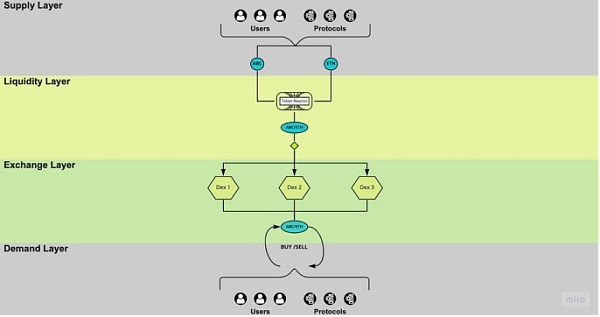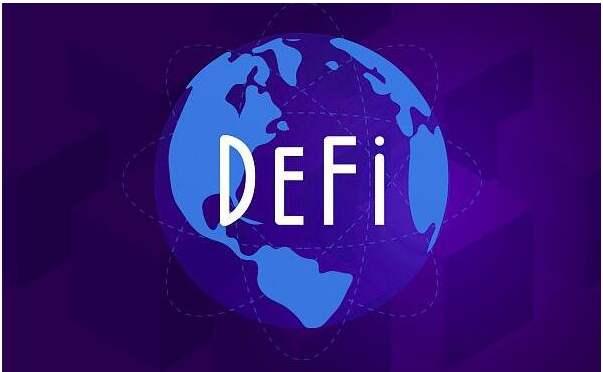Tokemak Founder: How Liquidity Becomes the Bandwidth of the Future Decentralized Economy
Original Title: "Tokemak Founder: Liquidity in the Web 3 Era = Bandwidth in the Internet Era"
Original Author: Liquidity Wizard, Founder of Tokemak
Original Translator: The Way of the Metaverse
The internet is changing at a tremendous pace.
The vast data exchange network known as the "internet" is evolving into an increasingly complex ecosystem where direct value exchange can occur in the form of tokens. Web3 will fundamentally change the economy, how businesses operate, how individuals work and organize, and how products are delivered and consumed. This decentralized economy requires grid access and network access (just like the internet).
Moreover, it also requires blockchain integration, and most importantly, it requires liquidity.
The goal of this article is to discuss how liquidity can become the bandwidth of the future "internet," and indeed the bandwidth of the entire future decentralized economy. Then, we will briefly discuss Tokemak's role in increasing liquidity bandwidth.
Broadband liquidity is almost here.

To better grasp the concept of liquidity as bandwidth, we should first understand the meanings of these two terms. We will start with the definition of bandwidth, as it is relatively straightforward, followed by the definition of liquidity.
Bandwidth
Network bandwidth is the speed at which data moves across the network. Therefore, more bandwidth represents more data flow. In a world where users communicate with each other over the internet, it is clear that higher bandwidth means a better internet-based economy (think of all the hype surrounding 5G).
Bandwidth is measured in bits per second (bps). In the early stages of the modern internet, consumers used dial-up modems to transmit data at a speed of 56 bps. This made early internet products like web pages and emails possible.
When Ethernet arrived, the game changed rapidly. Ethernet increased bandwidth to speeds of up to 10 Mbps. This means that compared to dial-up modems, Ethernet could send about 180 times more data over the internet. Broadband bandwidth and data transmission have arrived!
Since then, speeds have become faster and are now typically between 1-10 Gbps (18,000-180,000 times more than dial-up data). These speeds are necessary to unlock a range of internet-based products that were unimaginable under dial-up's low bandwidth. Streaming services like Netflix, cloud gaming, and always-online servers in the cloud are all made possible by the increase in current internet bandwidth.
However, more importantly, reliable network bandwidth requires not only strength and speed but also sustainability. Users send and parse data asynchronously over the internet, which means reliable bandwidth needs to be available on demand. More on this later.
Liquidity
Liquidity is a somewhat difficult concept to define. In DeFi/Web3, liquidity is used to define tokens (value) that can be provided or parked almost anywhere. While the general use of this term is not incorrect, we will attempt to clarify it more specifically here.
We define liquidity in a more targeted way, as the ability to exchange one token for another. In a sense, liquidity is the magical juice used for trading and converting tokens. For example, if I have ABC Token and I want to trade or "convert" it into XYZ Token, then I need to interact with liquidity.
In trading terms, I need to interact with the liquidity of ABC/XYZ, meaning I am selling ABC for XYZ. Selling ABC/XYZ means I am selling my ABC in exchange for XYZ.
Next, let's discuss the quality of liquidity, starting with poor liquidity.
Poor liquidity refers to any liquidity where you lose a significant amount of value when you interact with it. This means that "thin liquidity" is poor liquidity. Thin liquidity occurs when there are not enough tokens available for trading. For example, suppose you want to sell ABC for XYZ, and assume that 1 ABC is currently worth 1 XYZ.
If there are not many XYZ available as liquidity, this means the available XYZ will be at a premium. You want to sell 10 ABC to receive the 10 XYZ you should get (at the price of 1 XYZ each).
But conversely, due to insufficient liquidity, you only received 8 XYZ in the trade. By interacting with scarce liquidity and purchasing XYZ at a price higher than its actual value, you lost a significant amount of value in the process (in this case, 2 XYZ).
On the other hand, good liquidity refers to any liquidity where you can retain most of your value when you interact with it. As you might guess, "deep liquidity" is good liquidity.
Let's return to the previous example. Recall that you want to sell 10 ABC for XYZ, with 1 ABC still worth 1 XYZ. In the case of deep liquidity, where there are plenty of XYZ available for purchase, you could walk away with 9.9999 XYZ. You still received slightly less than 10 XYZ, which is the cost of acquiring liquidity. But you retained almost all of your initial value.
Author's Note: Some exchanges may offer better or worse pricing for the same level of token liquidity, but that is beyond the scope of this article!
"Deep liquidity" means retaining value when trading between tokens, while "thin liquidity" means a loss of value when trading between tokens.
In other words, when there is deep liquidity, you can trade at market prices. In the case of thin liquidity, prices will fluctuate significantly when you interact with it.
Who Needs Liquidity?
After discussing bandwidth and liquidity, we next need to understand why this is important and who truly needs liquidity. In a word: everyone. Moreover, this is not broad enough. It indeed includes everyone and everything.
The above discussion might give the impression that only traders should care about liquidity. In Web3, this is not far from the truth. All users interact with liquidity because all users need to buy and sell the tokens required by the token economy. Similarly, all protocols need to interact with liquidity because they will buy/sell and lend/borrow between themselves and other protocols.
Here are a few examples.
Example 1
First, let’s illustrate with an example of a user seeking yield. Suppose a user wants to earn APR from staking ABC. They are likely to start with ETH or USDC (or another stablecoin), so they need to interact with the liquidity of ABC/ETH to obtain the initial ABC for staking.
At the same time, they start accumulating yield. Once they claim it, they may want to sell it to pay bills, shop, or make other investments. Again, they will interact with liquidity to do this.
Example 2
Suppose a gaming user decides they want to purchase property and an avatar in a new "P2E" game. And the game only accepts the in-game currency ING. Then, the user first needs to trade with the liquidity of ING to obtain ING. Next, the user will use ING to purchase property NFTs and avatar NFTs, again interacting with liquidity (this time the liquidity of ING with NFTs).
Example 3
Many protocols function by converting part of their TVL into something else based on a specific trigger. For example, suppose Protocol A interacts with Protocol B to hedge when the price reaches a certain point.
When the trigger occurs, Protocol A needs to take a certain amount of their Token AAA and exchange it for Protocol B's BBB so that it can interact with Protocol B. A specific case in this regard is the liquidation of MakerDAO vaults when the value of collateral falls below the minimum collateralization ratio. When this happens, in addition to existing liquidation penalties, enough collateral must be sold to cover the debt.
Example 4
Suppose a DEX protocol relies on the liquidity provided by liquidity providers (LPs) to operate its entire business model. Then, more liquidity deposited means they can offer better pricing (less value loss for users). This, in turn, attracts users to trade here rather than elsewhere, increasing the trading volume through that DEX. Of course, an increase in trading volume means an increase in fee revenue generated by the DEX.
After exploring several examples of how liquidity is used in Web3, we will continue to discuss the issue of liquidity bandwidth.
Liquidity = Bandwidth
In this new "value internet," fundamentally, doing anything requires liquidity. Therefore, in this world, liquidity serves the role of bandwidth.
Recall that as the data internet developed, additional bandwidth was needed to do more things and move more data. Low data bandwidth means participants cannot move more data. You simply could not create Netflix until you had enough data bandwidth to reliably transmit movies over the network.
In the value internet, more liquidity is necessary to do more things and move more value. Thin liquidity means participants will not transfer greater value because their value loss is too high. Imagine an economy where value cannot flow freely because it loses value with every exchange or transfer. This is the current state of DeFi and Web3.
Value transfer has replaced data transfer, and liquidity is the new bandwidth of Web3 networks. The problem is that current liquidity bandwidth is thin and unreliable. Look at how many tokens are sitting idle, rather than being used as liquidity. The answer is most of them.
Take ALCX as an example; on Sushiswap, less than 20% of its circulating supply can be used as liquidity. Additionally, there is extra non-circulating supply, so the vast majority of ALCX tokens are not actively used as liquidity. Note that this is not specifically targeting ALCX; rather, it is an example that applies universally to all phenomena.
The fundamental reason for thin liquidity is that the DeFi space has introduced too much friction for users to become LPs. For a normal holder, there are three key reasons they do not provide liquidity:
Challenges in user experience
Impermanent loss
Inefficient capital
The challenges in user experience arise because seasoned users can discover and provide liquidity to Uniswap, Sushiswap, or Balancer (as an example), while ordinary users are deterred by the entire experience.
For those capable of facing the user experience challenges, they still need to understand impermanent loss and be willing to take on that risk. Moreover, they need to have the "other side" of the trading pair, which makes their capital efficiency very low when providing liquidity. For example, if they want to provide ABC liquidity, they need to simultaneously hold and provide both ABC and ETH to provide ABC/ETH liquidity.
The result is that liquidity in DeFi is currently in a dial-up state. There simply isn't enough liquidity to facilitate and encourage low-value loss transfers.
Furthermore, existing liquidity is very unreliable. Projects often incentivize their liquidity through inflationary rewards. And this inflation-based liquidity is unsustainable and can be turned off in an instant. Stop the rewards? Lose liquidity. Keep the rewards? Dilute your token's value.
Neither outcome is good.

Tokemak is a solution designed to address these issues by unlocking deep, reliable, and sustainable liquidity bandwidth.
How Tokemak Solves the Liquidity Problem
Tokemak is a tool attempting to usher in a broadband moment for liquidity bandwidth. This bandwidth will unlock the Web3/DeFi/GameFi applications that people have long dreamed of. Tokemak's liquidity engine will power all of this.
So, what is Tokemak?
Tokemak is a unified liquidity layer for Web3, spanning all DEXs, chains, and layers. It eliminates the friction for users to become liquidity providers, significantly enhancing liquidity bandwidth. The diagram below illustrates the functionality of Tokemak.

Starting from the top of the diagram, any user or protocol can provide liquidity simply by depositing their ABC directly into Tokemak. They do not need to face the user experience challenges of LPing at the exchange level, nor do they need to bear the risk of impermanent loss.
They can simply deposit the assets they own without needing to pair them with other assets (ETH, USDC, etc.). In this way, Tokemak transforms unilateral liquidity supply into bilateral liquidity in the market, drawing from unilateral asset pools.
Users known as liquidity directors guide the routing of liquidity across all DeFi. The routing provides the economic bandwidth that Tokemak offers, ensuring liquidity and ensuring the success of DEXs, chains, L2s, and stablecoins by providing a full spectrum of liquidity. Users and protocols can then go to exchanges and interact with the deep liquidity provided by Tokemak (by buying and selling into it).
If you look again at Tokemak's diagram, you will notice something very interesting. The supply layer and the demand layer are the same: they are both composed of users and protocols as participants. This is because with Tokemak, everyone can now become a passive liquidity provider.
When all the underlying assets of the entire network sit as liquidity in DEXs and can flow freely according to participant demand, this unified liquidity layer becomes powerful for all users, and value loss is minimized for everyone.
The Future
So, what happens when the maximum liquidity bandwidth is provided? This is the ultimate state of liquidity bandwidth, and Tokemak will fulfill its destiny as the liquidity engine driving the entire network.
The decentralized economy will truly be unleashed.
As we move toward a future with broadband liquidity, it becomes quite challenging to imagine what that future will look like. While we know that deep liquidity will enable reliable pricing and less volatility, its implications are even more fascinating.
Trying to imagine what will be possible with the upcoming deep liquidity bandwidth is as difficult as it was for someone using dial-up internet in 1995 to envision Netflix streaming videos to mobile phones. The future innovations unleashed by deep liquidity bandwidth will be even more significant.
Nevertheless, I will attempt to speculate on a few innovations that I believe are on the horizon, built on the foundation of broadband liquidity.

First, think about how challenging it is for individuals in developing countries to obtain loans for significant moves like buying a home.
In most cases, financial infrastructure (i.e., banks) either does not exist or individuals have no access to the system. In a democratized financial new world with deep liquidity bandwidth, an individual's cash flow can be verified on-chain, and lenders from around the world can provide loans or mortgages to that person on demand. Smart contracts can instantly check cash flow and verify an individual's on-chain activity, flowing funds to their wallet the moment they request a loan.
Second, imagine an entrepreneur with a great idea for a new on-chain business but lacking the capital to start. In the future, users will post an overview on the internet and launch it to initial "idea investors" using a token template.
Individuals and protocols will see these materials, decide whether the idea is valuable, and fund the new venture at the seed stage (or pre-seed stage). This will compress the entire capital-raising process to occur immediately after the idea and model are formed; this is every entrepreneur's dream.
Finally, imagine the world we are moving toward through GameFi and the metaverse. Everyone will have their own identity, data, and cash flow associated with that data and identity.
Web2 giants will no longer own users. Built on deep liquidity, tokens used for payments and incentives can flow in real-time to individuals on the blockchain. As users interact, purchase, contribute, and simply spend time in a virtual "always-on" universe, all forms of entertainment and gaming can direct value and payments to participants as easily as achieving high scores in today's video games.
In summary, the upcoming deep liquidity bandwidth will allow any value to flow freely, without friction, intermediaries, or rent-seekers.
The future will be even more incredible and harder to imagine than the examples outlined above. The entire economy will soon operate on liquidity bandwidth, and you heard it here first.











